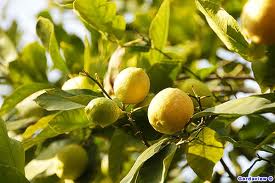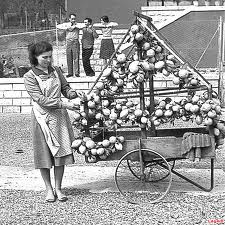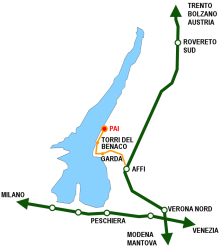 Citrus fruits from the Orient to GardaCitrus fruits originate in China and India, but can be found around the globe. They first arrived in Europe with the Arabs around the year 1000. Several scholars believe that Sicily was the first Italian region to grown them, “probably under the Islamic influence first, and then under the Normans.”
Citrus fruits from the Orient to GardaCitrus fruits originate in China and India, but can be found around the globe. They first arrived in Europe with the Arabs around the year 1000. Several scholars believe that Sicily was the first Italian region to grown them, “probably under the Islamic influence first, and then under the Normans.”Citrus fruits were brought from the Liguria Riviera to Lake Garda during the 13th century by the monks of the San Francesco Monastery of Gargnano. From their garden, which still at the end of the 19th century was called the “first, because it was the first structure and cultivation” , citrus fruit trees later spread toToscolano Maderno.
 The structure of the lemon houseWater from a stream, a sheltered valley, a gently sloping hill, and proximity to the lake garda were the fundamental requirements for building an enclosedlemon garden called lemon house or sardì in the local dialect. Often built on several terraces (còle), linked by stone stairs, these structures came in many different sizes. A massive wall enclosed it on three sides to ensure an eastern-southeastern exposure. At its center or on one of its extremities was the casèl, a shed for storing roofing materials.
The structure of the lemon houseWater from a stream, a sheltered valley, a gently sloping hill, and proximity to the lake garda were the fundamental requirements for building an enclosedlemon garden called lemon house or sardì in the local dialect. Often built on several terraces (còle), linked by stone stairs, these structures came in many different sizes. A massive wall enclosed it on three sides to ensure an eastern-southeastern exposure. At its center or on one of its extremities was the casèl, a shed for storing roofing materials.
 Growing lemonsEach tree in the lemon house had an available surface area of between 16 and 20 square meters that was called a plot (cap or campàa). The number of plots determined the size of a garden. Already in the 16th century Agostino Gallo established several rules forgrowing lemons, recommending that the plants have rich gravel-free soil and that fertilizer be spread before the soil was hoed and the lemon house was still uncovered . Besides fertilizing, the soil had to be weeded and hoed, the trees had to be pruned and irrigated, and the lemon house had to be covered and uncovered. The lemons were picked (spicànda) by hand while pickers stood on special ladders or three-legged stools, and were then placed in a leather sack (grümiàl).
Growing lemonsEach tree in the lemon house had an available surface area of between 16 and 20 square meters that was called a plot (cap or campàa). The number of plots determined the size of a garden. Already in the 16th century Agostino Gallo established several rules forgrowing lemons, recommending that the plants have rich gravel-free soil and that fertilizer be spread before the soil was hoed and the lemon house was still uncovered . Besides fertilizing, the soil had to be weeded and hoed, the trees had to be pruned and irrigated, and the lemon house had to be covered and uncovered. The lemons were picked (spicànda) by hand while pickers stood on special ladders or three-legged stools, and were then placed in a leather sack (grümiàl).
 The lemon tradeOnce the lemons were picked, they were sorted according to size (fine, superfine, second-rate, rejects, and overly ripe) and different destinations. The fine, superfine, and best of the second-rate lemons went to Hungary, Tyrol and nearby countries, “leaving in Italy the second-rates and rejects, which were rarely sold outside the province.”
The lemon tradeOnce the lemons were picked, they were sorted according to size (fine, superfine, second-rate, rejects, and overly ripe) and different destinations. The fine, superfine, and best of the second-rate lemons went to Hungary, Tyrol and nearby countries, “leaving in Italy the second-rates and rejects, which were rarely sold outside the province.”
 The crisisThere were 6.59 hectares of citrus groves inLimone sul Garda by the second half of the 19th century. The first harvest of 1874 amounted to 76,000 lemons, the 1876 harvest was “just one sixth of what was harvested in 1875”, and the 1878 harvest was “scarce and less than the previous year.” The 1879 harvest was “50% that of an average harvest when the plants were not sick”. An agricultural survey in 1879 estimated that production amounted to 550,000lemons, 8,000 oranges, and 3 quintals of citrons.
The crisisThere were 6.59 hectares of citrus groves inLimone sul Garda by the second half of the 19th century. The first harvest of 1874 amounted to 76,000 lemons, the 1876 harvest was “just one sixth of what was harvested in 1875”, and the 1878 harvest was “scarce and less than the previous year.” The 1879 harvest was “50% that of an average harvest when the plants were not sick”. An agricultural survey in 1879 estimated that production amounted to 550,000lemons, 8,000 oranges, and 3 quintals of citrons.
 Buy your Garda lemons here!Construction on the Gardesana Occidentale roadbegan in 1929. Centuries of isolation ended in October 1931 when the road was inaugurated and finally linked Limone sul Garda with Gargnano andRiva del Garda.The future looked much brighter for the town. Afterwards, tourism gradually increased, although it was still very limited and sporadic.
Buy your Garda lemons here!Construction on the Gardesana Occidentale roadbegan in 1929. Centuries of isolation ended in October 1931 when the road was inaugurated and finally linked Limone sul Garda with Gargnano andRiva del Garda.The future looked much brighter for the town. Afterwards, tourism gradually increased, although it was still very limited and sporadic.
 Lemon houses are a heritage to saveThe lemon houses, which are an incomparable historical and architectural legacy of Lake Garda, are vestiges of a laborious and productive past. Several major projects have been launched to preserve them.
Lemon houses are a heritage to saveThe lemon houses, which are an incomparable historical and architectural legacy of Lake Garda, are vestiges of a laborious and productive past. Several major projects have been launched to preserve them.
 The Pra dela fam lemon house in TignaleAccording to a document dated July 27, 1754, the Parisini family of Gargnano bought land at Pra dela fam, a tiny strip of land along the lake garda between the mouths of the Piovere and Baès Torrents, where they built their first garden, now called the “Old Garden”. In 1850 they added the “New Garden”, further south, that covered eight terraces.
The Pra dela fam lemon house in TignaleAccording to a document dated July 27, 1754, the Parisini family of Gargnano bought land at Pra dela fam, a tiny strip of land along the lake garda between the mouths of the Piovere and Baès Torrents, where they built their first garden, now called the “Old Garden”. In 1850 they added the “New Garden”, further south, that covered eight terraces.
 The Tesöl lemon houseTesöl is a town that sits below the Preàls mountain and is about 2 kilometers from downtown Limone sul Garda. The date “1740” and the initials “L.C.V.” can still be seen next to the jamb of the door leading from thelemon garden to the house. The Bertelli family sold the lemon house to Count Giacomo Ferrari in 1820. The property was composed of 107 campa’ plots, distributed over six còle (terraces) for a total surface area of 1,221 square meters. The supply of water was guaranteed by the Tesöl River, to the south.
The Tesöl lemon houseTesöl is a town that sits below the Preàls mountain and is about 2 kilometers from downtown Limone sul Garda. The date “1740” and the initials “L.C.V.” can still be seen next to the jamb of the door leading from thelemon garden to the house. The Bertelli family sold the lemon house to Count Giacomo Ferrari in 1820. The property was composed of 107 campa’ plots, distributed over six còle (terraces) for a total surface area of 1,221 square meters. The supply of water was guaranteed by the Tesöl River, to the south.
 The Castèl lemon house in Limone sul GardaThe Castèl lemon house, which is northwest of the old town center and stands against the rocky wall of the Mughéra mountain, is just a portion of the large lemon grove that once stretched from the Mura valleys, Via Pozze and Via Castello to the Màndola valley. The garden, which covers an area of 1,633 square meters, is divided perpendicularly into two parts by the cùen dela Marchesàna, on which the main casèl is built on several levels.
The Castèl lemon house in Limone sul GardaThe Castèl lemon house, which is northwest of the old town center and stands against the rocky wall of the Mughéra mountain, is just a portion of the large lemon grove that once stretched from the Mura valleys, Via Pozze and Via Castello to the Màndola valley. The garden, which covers an area of 1,633 square meters, is divided perpendicularly into two parts by the cùen dela Marchesàna, on which the main casèl is built on several levels.
 The Villa Boghi lemon house
The Villa Boghi lemon house
The lemon house in the garden of Villa Boghi, which is at the junction of the lakefront boulevard and theGardesana road, was built in the early 20th century. It has seven plots with a southern exposure. The pillars and roofing materials are new, and the seven lemon trees were planted in 2004.
There is an exhibit area at the back of the garden, with panels illustrating the history and characteristics of the citrus fruit.









 Updating...
Updating...